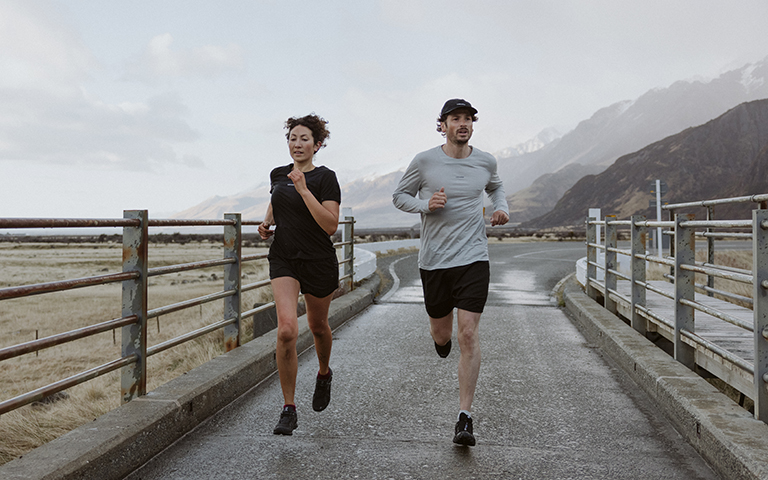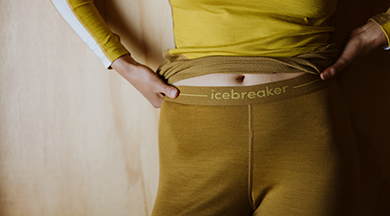A beginner’s guide to ski clothing
08 March 2023
As a beginner skier, you want to ensure you can focus entirely on the task at hand. Wearing unsuitable clothing can become an obstacle that will interfere with your movement.
Clothes that are too big or small can make you less steady and more likely to have an accident while skiing. An outfit that doesn’t keep you warm (or that is too hot) will distract you. And wet clothes are not just heavier and uncomfortable but they may even put you off skiing altogether. So how can you determine what to wear skiing?
What to wear when skiing for the first time
The typical initial choice for many people is to opt for a thick and plush jacket. It’s natural, as they want to ensure they are warm enough in cold temperatures. However, this option doesn’t offer you a lot of flexibility and mobility when you’re rushing down the slope. In addition, if you get too hot, you can’t remove it, as the thin layer underneath won’t be enough to keep you warm in the snow.
Another common trend is oversized hoodies and designer sweatpants. While these are definitely fashionable, they don’t provide much protection against moisture. As a beginner, you’re sure to fall once or twice, so you want to make sure your clothes don’t get wet in the process.
Layering your ski clothing
The optimal way to dress for this winter sport is with light, form-fitting layers. The most apparent advantage is the ability to adapt your layers based on the weather and your personal comfort level. If you get too cold, you add a layer. If it is too warm, you remove one.
Layering up, also, actually offers you more insulation. It traps the air closest to your body, which is warm, thanks to your core temperature. Any additional layer also traps air in between the clothes. So the more layers - the more insulation, even if the layers themselves are not warm on their own.
With this way of dressing, it is also easier to move around. It might be more clothing in total, but they are usually thinner and weigh next to nothing. After all, it’s hard enough to balance yourself at the beginning. You don’t want to have to handle any more weight in addition to that.
The materials, thickness, and number of layers will change accordion to your skiing holiday destination and the season you go choose to go. But in general, we recommend three layers.
Base layer
The base layer of ski wear is the closest to your skin. It should fit almost as a second skin, and some refer to it as long underwear. The goal of this layer is not to keep you warm per se but to keep you dry (of sweat). This, in turn, will ensure you stay warmer.
For that reason, the base layer is usually made of merino wool. This natural fibre is great at managing moisture and keeping odours at bay while doing so.
Mid layer
Over your base layer, you should usually wear a thin jumper, a jacket, or a fleece. We recommend you pick a mid layer with a zipper, which is easier to take off if you get too hot. It doesn’t need to be anything too fancy. So if you don’t want to invest for your first time, a hoodie from your closet can probably do the trick.
The purpose of this type of ski clothing is, again, to trap more warm air. If you plan on skiing in extremely cold weather, you can even have two mid layers.
However, a bottom mid layer is usually not necessary. Our legs don’t really get as cold as the rest of our bodies. On top of that, when you ski, your legs work the hardest, so you’ll probably be fine there.
Outer layer
The final skiing wear is the one that keeps you safe from the elements, whether it’s wind, snow, or sleet. The bottom part of the outer layer (ski trousers or salopettes) might not always be that fashionable. However, that doesn’t mean you should skip it in favour of aesthetic Instagram posts. These trousers are especially essential for beginners, who might end up skiing on their bums.
When it comes to the right ski jacket for you, there are a lot of options out there. Some are warmer than others. There are hardshell and softshells, with or without a hood. The most important thing to keep in mind is that the jacket should be just as breathable as it is warm to allow your sweat to evaporate.
Accessories
It’s important to remember that if you want to maintain body heat, you need to be fully covered. So other than tops and bottoms, here are other items to consider when you think about what to wear skiing:
- Socks: the right ones will keep you warm and ensure that the boots are comfortable and don’t chafe.
- Beanie: you should wear this under your helmet (or hood and helmet) for additional warmth.
- Gloves: You can’t keep your hands in your pockets for obvious reasons, and they will freeze otherwise. We recommend water-resistant gloves for the best performance.
- Scarf: or a snood if you’re looking for something more snug.
Pick ski clothing that you love wearing
Now that you understand the practicalities of ski clothing, it’s time to think about personal taste. There’s no point in owning top-rated skiing wear that you despise wearing. If your clothes make you feel frumpy, you won’t enjoy going skiing, and soon enough, you’ll abandon the sport altogether. So especially when you shop for a women’s or men’s outer layer, go with your heart, as well as your brain.
More for you

Merino socks for hiking | icebreaker
26 August 2020 | Marie Knowles

The Tech Behind ZoneKnit™ | icebreaker
16 September | Jamie Patterson

Washing Merino Wool Clothes | Does Merino Shrink?
28 September 2020 | Marie Knowles
More for you








